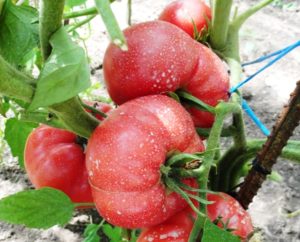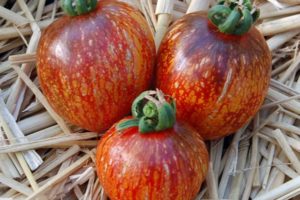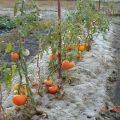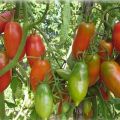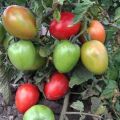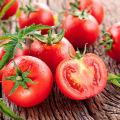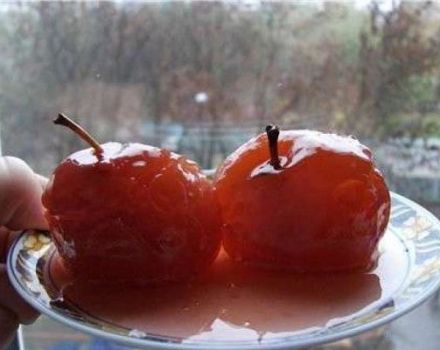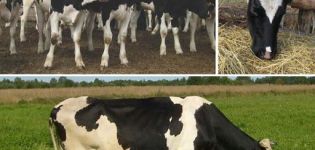Characteristics and description of the heavyweight tomato variety in Siberia, its yield
Tomato The heavyweight of Siberia is a variety of early ripening tomatoes. Recommended for cultivation on the lands of private household plots, which is confirmed by the inclusion of this variety in the State Register in Russia. It pleases gardeners with its size and taste.
Description of the variety
The Siberian heavyweight, as it appears in some catalogs, is intended for cultivation in open field conditions.
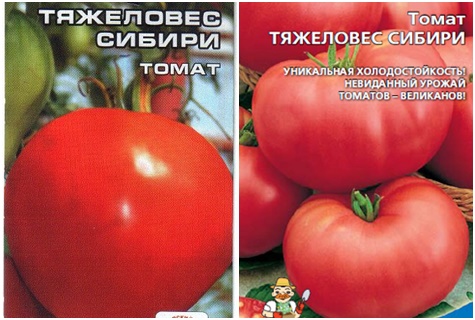
Plant height reaches 60-80 centimeters. Despite the low growth of the plant, there is a high risk of breaking off the stems under the weight of the vegetables. Due to the large weight of the fruit, tying to a support requires not only the stems, but its brushes. The leaf is indistinguishable from other tomatoes, has a dark green color and medium size.
After the first shoots, 96-106 days will pass and the tomato Heavyweight of Siberia can be eaten. These tomatoes gained their popularity due to several advantages:
- Heavyweight Siberia is a disease-resistant tomato;
- Low temperatures are not the reason for a decrease in yield, which means that this variety is perfect for growing in Siberia;
- The plant bears fruit equally well both in open and protected ground;
- The fruits have a wonderful appearance;
- Tomatoes tolerate transportation well;
- Large fruit sizes.
Tomatoes of the Heavyweight of Siberia variety have found their application among housewives in the manufacture of juices and pastes, in addition, they are used fresh and added to salads.
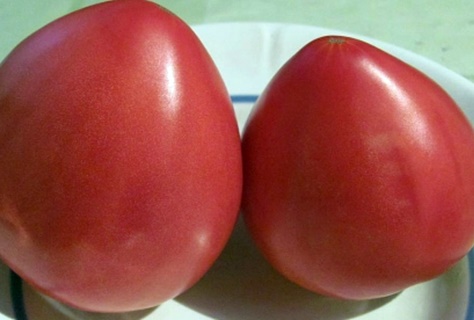
The average weight of a tomato varies from 400 to 500 grams.
The fruits are deep pink in color. The shape is heart-shaped, slightly flattened. The pulp is fleshy and juicy. The taste is sweetish. The number of chambers in fruits is four or five.
Such vegetables are not suitable for canning.
Climate
The description and characteristics of the tomato variety Heavyweight of Siberia indicate that it is absolutely not intended for hot climates (more than +30 degrees). Therefore, this variety cannot be found in warm regions. For seed germination, the optimum temperature will be 23-25 degrees.
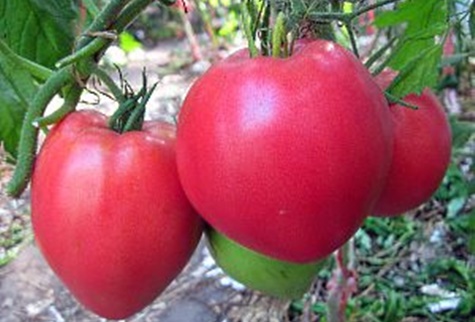
Therefore, what kind of harvest the gardeners will gather depends on what summer will be. A moderate temperature during the summer will bring tasty and large-fruited crops to gardeners. Hot weather will significantly reduce tomato yield.
Those who planted such plants noticed that choosing the right place for planting will help protect themselves from sour fruits. It should be well lit and sunny. In this case, the fruits will be delicious.
There is a difference in planting timing for different growing methods:
- In April, tomatoes are planted in heated greenhouses;
- In May, the time comes to plant a Heavyweight in greenhouses without a heating system;
- June is a good time to plant outdoors.

A place for planted tomatoes is chosen by neutral, light and highly fertile soils. Sowing seeds is carried out 60-65 days before the intended planting in the ground.
This culture must be watered abundantly with warm water and fed with fertilizers, which include minerals. A tomato should be dived when a couple of leaves appear. The plant is fed when planting in the ground, as well as as soon as the first ovaries appear.
Stepsons need to be removed if the task is to get a luxurious bush and grow large fruits. But this is not mandatory. Also, to get large fruits, the ovaries are cut off, thereby you can get tomatoes weighing 700-800 grams.
Description of the variety Heavyweight of Siberia has a strict planting scheme: 3-5 plants per 1 sq. m. plot. If you ignore this recommendation, yields will suffer.
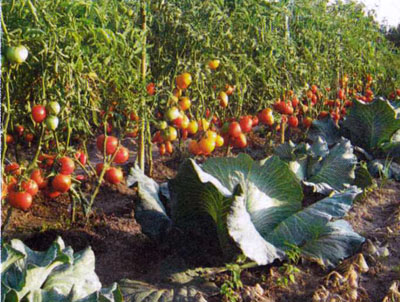
Tomato care consists of:
- Timely watering of plants;
- The use of dressings, which include mineral fertilizers;
- Prevention of plant diseases;
- Stepping out (if necessary);
- Weed removal.
In subsequent years, it becomes possible to grow this crop from its own seeds. That guarantees a great taste of the harvest.
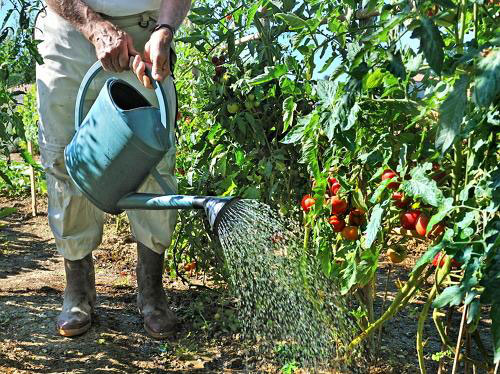
Diseases
Diseases threatening the Heavyweight:
- Late blight, a disease that affects tomatoes, can quickly destroy an entire crop and become a source of infection for other plants. It is imperative that gardeners understand that late blight is not like other diseases. Most often, the disease affects only the leaves or causes limited damage to the fruit, and although they can reduce the yield, they usually do not cause complete loss. In addition, since most pathogens are not easily dispersed by the wind, their effects are localized. On the other hand, late blight kills plants directly and is highly contagious. Its appearance in one garden can affect other gardens due to wind-dispersed spores.
- Root Rot - As the name suggests, the disease affects the root system. The disastrous result that the death of the plant will become is obtained from the latent form of the disease. Since the disease of the root system is not visible to the eye, it is difficult for a gardener to recognize the onset of root rot of his tomatoes.
- Tobacco mosaicism can cause yellowing and stunted plant growth, resulting in loss of persistence and reduced yield. In addition, the virus can cause uneven ripening of the fruit, further reducing the yield.
To prevent diseases, comprehensive measures are needed at all stages of tomato cultivation.
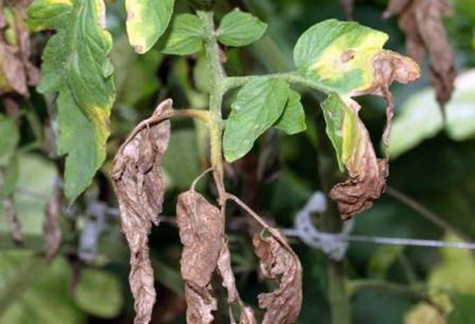
Reviews
Considering the reviews of gardeners, it is safe to say that the Heavyweight of Siberia tomato variety has a high similarity with such varieties as the Noble and Danko.
Those who grew this variety note positive features, which are:
- Pleasant taste;
- Early maturity;
- Meatiness;
- Large fruit sizes;
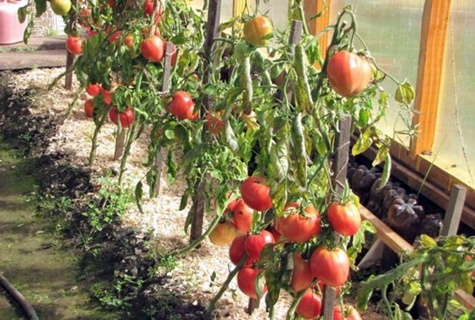
The negative qualities of the fruit include:
- Low plant growth, which is not convenient when growing in a greenhouse;
- Small amount of seeds;
In general, those of the gardeners who planted the Heavyweight prefer it, despite the low yield of these vegetables. Positive qualities outweigh this factor. The characteristic and description of the variety attracts gardeners. By right, the Heavyweight of Siberia is highly valued by tomato lovers.
